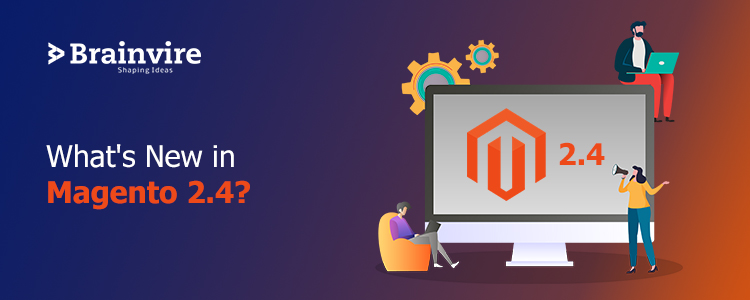
After it was announced in 2019 that Adobe has acquired Magento, murmurs of the platform upgrade circled back and forth in the community. It took nearly a year after the acquisition for the rumors to be a reality as on June 2020, when the official statement came out. Finally, it was on July 28, the same year, when Magento 2.4.0 was released for everyone to install and upgrade.
The beta version indicated some final changes, so it was not a big surprise. The users knew what they could expect from the update. The developers from the Magento team who did speak about the nature of changes would be more inclined towards fixing bugs than adding a whole lot of new features in eCommerce development.
The final product was a mix of both eliminated bugs and new features. Here, we will talk about both the changes and see how these changes can affect your e-commerce business.
Detailed Input on the Need-to-know Changes
1. A Refreshing PWA Studio
The earlier version of PWA did not meet standards for reliability, efficiency, cost-effectiveness, and turnaround time. There were some evident problems and the Magento developers removed those bugs with a revamped PWA studio that has a venia-style UI and new tools to augur the development process.
[Also Read: The PWA Edge: Magento PWA Studio vs Vue Storefront]
In the earlier version, as the PWA rolled out, it was not the end of the process. Several workarounds had to be introduced to include extensions and every new Magento update.
Some of the new enchantments made to the PWA studio include,
- A completely restructured cart, and a revamped checkout process to adjust with the dynamic workload
- Venia UI is incorporated with the storefronts that are driven by the Adobe Experience Manager
- Pushing the efficiency of the PWA with an extensible framework
2. Seller Assisted Shopping
Seller Assisted Shopping is a new way to enhance the digital infrastructure and to avoid human incompetency. However, that’s not entirely true, if you had a customer representative better than an automated system in handling customer through each step of the buying process. More so, if the representative was available 24×7 for real-time troubleshooting.
Let’s face it, such a level of operational efficiency with a customer representative is quite a wily expectation. This is where the SAS feature of Magento 2.4 comes in handy. Here the customer rep or administrator or Magento development company can enter the platform as a consumer, and get a sense of complete customer journey through the platform.
Assessing the challenge as a consumer helps chalk out changes needed to be included for CJO (customer journey optimization). With this new feature, a rep can guide the consumer in a better way without being too intrusive. They can fasten the order time and checkout process for the customer owing to their rich storefront experience over the period of time.
3. Improved Media Gallery that Works 30x Faster
Like various other core issues, the preceding line of Magento solution did have issues with image management. The new version of Magento has got the image side of things well rounded. As the developers claim, the newly included media solution is 30x times faster than the previous.
The 30x faster speed comes from the Adobe Stock Integration v2.0, which provides every bit of information about the image right from the media gallery. You can even license the images from the gallery and would not have to migrate to third-party resources. With expert AEM consultancy services, you can optimize this integration for seamless digital asset management.
Now, store owners can optimize their image by assessing the frequency of usage for a particular type of image. It is a known fact in the e-commerce industry that images sell. Further, if you have the tools to know what type of images works better for a particular page, the chances of conversion increases.
[Also Read: How to Set up Tax Rules and Related Configuration in Magento 2]
Another interesting aspect of the new media infrastructure is that you can streamline the access to the images gallery through a series of permission checks.
4. Completely New Default Search Engine: Elastic Search Engine
Shift from traditional, and to some extent outdated, MySQL-based search engine to Elastic was always in the offing. The only factor that might have pushed back its rollout would have been the apprehension towards the cost factor for the store owners.
The very first step that the user undertakes as soon as they land on the page is that they look for products in the search engine. Elastics search engine gathers results for any queries from multiple servers, so the user finds the product that they are looking for faster.
Now, there are various technicalities related to the search engine change. Firstly, you need to be sure of the kind of search engine that your storefront is offering to the users. If it’s MySQL or any other version of elastic search other than 7.6, replace it.
5. Security Enhancements
Magento 2.4 comes with enhanced security features as a native component. Yes, we are talking about two-factor authentication. Now, you do not have to rely on third-party app integration for 2FA.
As a standard security protocol, we have the username and password, and to a certain extent, captcha to allow logins. But if there is a slight glitch in the sophistication of password encryption, it becomes easy for the fraudsters to get access to your account.
To tackle this situation, there is a feature called 2FA that goes beyond username and password combination to grant access. In this case, the user will receive in their registered numbers, the validity of code is normally for 30 seconds. So, it becomes tough for hackers to bypass security measures and get access to crucial information.
Conclusion
The 2019 updates of Magento mostly focused on fixing the critical bugs, and include a host of new features to power online stores. Things are no different with the new updates, but certainly, there are new crucial features, like the elastic search engine, and security enhancement. However, experts believe that the users must be calculative in their migration process to Magento 2.4.
Related Articles
-
What Makes NopCommerce A Perfect Choice For Ecommerce Platform?
Talking About What Makes NopCommerce A Perfect Choice For Ecommerce Platform? NopCommerce is a customizable and stable .Net-based open source e-commerce engine. It includes a wealth of services and features,
-
Engage International Audiences at Lower Costs with Shopify Market
According to BCG, the future of e-commerce looks promising, with experts forecasting that online sales will account for up to 41% of global online store retail sales by 2027. This
-
Magento Commerce: Why is it a better choice for B2B Users?
Magento is a well-renowned brand that formerly used to deal with products for the B2C commerce market. But with the launch of Magento 2.2, things changed. Now the platform has



